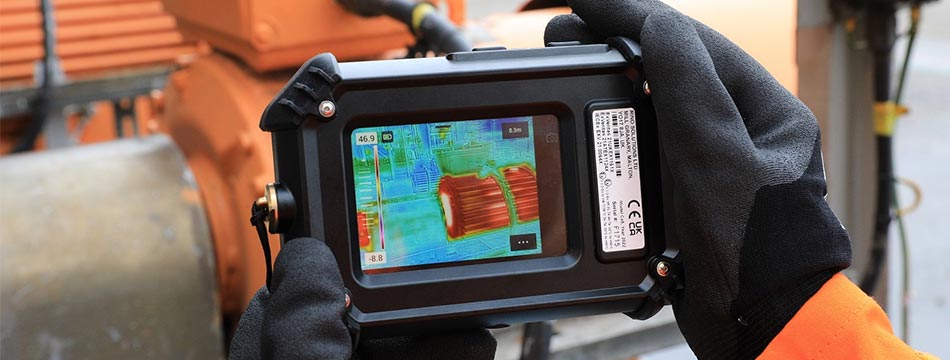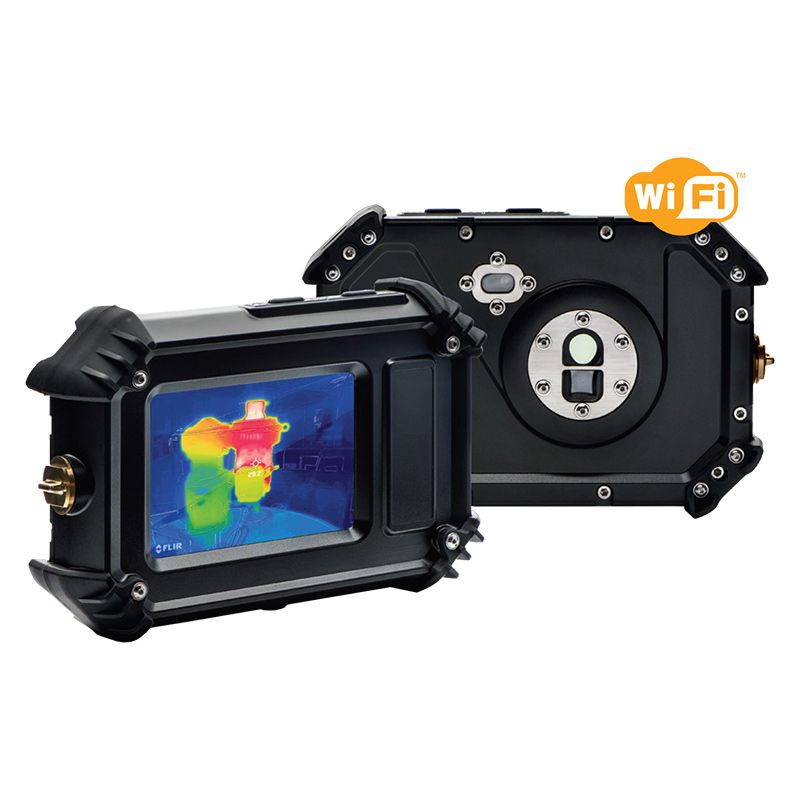
Explosions in hazardous areas are extremely costly. They endanger invaluable lives and can result in damage totalling hundreds of millions of pounds. Explosions occur when volatile gasses or dust in the atmosphere reach ignition temperature. According to conservative estimates, a major dust explosion takes place somewhere around the globe every 2.9 days! Predictive maintenance routines that include regular T-class temperature checks are an effective method of preventing such catastrophes. However, as suggested by their name, hazardous locations are dangerous. Therefore, unless your inspection tools are suitably certified for the site/s you are working in, you could increase your risk of explosion. Thankfully, Teledyne FLIR has designed an ATEX/IECEx-certified, pocket-sized thermal camera. It allows you to capture thermal images and temperatures without the need for hot work permits, and makes T-class surveys quick, safe, and easy.
Quick Links
- What is a Hazardous Area?
- How are Hazardous Areas Classified?
- Why Choose Teledyne FLIR’s Cx5 Thermal Camera?
- Which Ex Category Is the Teledyne FLIR Cx5 Thermal Camera In?
- Where Can the Teledyne FLIR Cx5 Thermal Camera Be Used?
- When Should the Teledyne FLIR Cx5 Thermal Camera Be Used?
- Who Can Use the Teledyne FLIR Cx5 Thermal Camera?
- Further Information
What is a Hazardous Area?
A hazardous area is any location where there is a potentially explosive mix of dust or vapours in the atmosphere. In these environments, there is a risk of explosion if specific conditions occur:
Gas Atmosphere
Fuel + Oxygen + Ignition Source = Explosion
Dust Atmosphere
Fuel + Oxygen + Dispersion + Confinement + Ignition Source = Explosion
Explosive areas are surprisingly common. Numerous locations across a multitude of sectors are classified as hazardous spaces.
Gas
- Offshore
- Marine (tankers)
- Refining
- Chemical manufacture
- Chemical distribution
- Distilling
- Cosmetics
Dust
- Cement and fine aggregates
- Grain and flour
- Powdered milk
- Sawdust
- Tobacco
- Graphite powder
- Toner
How are Hazardous Areas Classified?
Not all hazardous areas are the same. Depending on the characteristics of each environment, such as its construction or its application/purpose, the risk of an explosion varies. In respect to this, spaces within hazardous locations are classified into Zones.
| Zone | Definition | Example Location |
| 0 or 20 | An explosive atmosphere is present continuously or for long periods. | Tanks containing hazardous fuel. |
| 1 or 21 | An explosive atmosphere is present continuously or for long periods. | Around a filling hose during fuel transfer (e.g. petrol station). |
| 2 or 22 | An explosive atmosphere is not likely to occur in normal operation but if it does it will only persist for a short period. | Everywhere else (e.g. outside/beyond the boundaries of a petrol station). |
Subsequently, necessary precautions vary between Zones and equipment must be appropriately certified.
Why Choose Teledyne FLIR’s Cx5 Thermal Camera?
Safety is at the forefront of the Teledyne FLIR Cx5 Thermal Camera’s design. As a non-sparking, Ex 3 ATEX/IEC/IECEx-certified tool, the Teledyne FLIR Cx5 Thermal Camera allows you to conduct T-class surveys in Zone 2/22 hazardous/explosive environments safely, simply, and swiftly. Featuring a 160 x 120px sensor, MSX imaging function, and adjustable temperature alarms, the Teledyne FLIR Cx5 Thermal Camera enables the fast, precise identification of above-temperature equipment from a safe distance. Furthermore, the built-in digital camera improves the clarity of images. This is because visible details can be overlaid onto thermal pictures (MSX imaging function). Additionally, you can document ATEX serial numbers for use in reports; once again improving the ease of T-class inspections.
Moreover, equipment in Zone 1/21 hazardous areas may be checked from the relative safety of Zone 2/22 locations thanks to the Teledyne FLIR Cx5 Thermal Camera's 160 x 120px sensor, which delivers a significant detection/measurement distance. It is important to stress that the Teledyne FLIR Cx5 Thermal Camera is not suitable for use inside Zone 1/21 explosive environments. Nevertheless, it does offer an advantage in that thermographers also do not need to enter these spaces or get close to potentially dangerous equipment. This significantly improves the safety of those conducting T-class surveys. Additionally, as engineers/technicians are no longer entering dangerous Zone 1/21 sites, the need for expensive hot works permits is negated.
Whichever way the Teledyne FLIR Cx5 Thermal Camera is integrated into your predictive maintenance routine, this simple-to-use, inexpensive, and safety-optimised thermal imager has the potential to prevent millions of pounds of damage and protect many priceless lives.
Teledyne FLIR Cx5 Thermal Camera Overview

- Non-sparking design
- Ex 3 category
- ATEX/IEC/IECEx certified
- Suitable for use in Zone 2 and 22 hazardous areas
- Corner shock absorbers
- Armoured shell
- Impact-resistant lens
- Pocket sized
- 160 x 120px thermal sensor
- Digital camera
- MSX function
- 1-touch level/span
- Wi-Fi connectivity
- Uploads images to the FLIR Ignite Cloud
- Compatible with FLIR's Thermal Studio analysis and reporting software
- Annotation function
- LED torch
- Charging, data, and test port
Buy Teledyne FLIR's Cx5 Thermal Camera
Which Ex Category is the Teledyne FLIR Cx5 Thermal Camera In?
The Teledyne FLIR Cx5 Thermal Camera is non-sparking making it an Ex category 3 instrument and therefore suitable for use in Zones 2/22. It is important to note that while the Teledyne FLIR Cx5 Thermal Camera is not intrinsically safe, this does not affect its suitability for use in Zone 2/22 explosive areas precisely because of its non-sparking design.
Where Can the Teledyne FLIR Cx5 Thermal Camera Be Used?
As an IEC/IECEx/ATEX-certified Ex category 3 instrument, the Teledyne FLIR Cx5 Thermal Camera is only suitable for use inside Zone 2 or 22 areas; i.e., environments in which, during normal operation, an explosive atmosphere is not likely to manifest but if one does occur will only remain present for a short period.
The Teledyne FLIR Cx5 Thermal Camera cannot be used inside Zones 0, 1, 20, or 21. However, thermal imaging provides a safe, non-contact method of conducting T-surveys. Featuring a non-sparking design as well as a 160 x 120px thermal sensor and MSX imaging function, the Teledyne FLIR Cx5 Thermal Camera allows you to inspect equipment in Zone 1/21 areas from the relative safety of Zone 2/22 spaces, without compromising on image detail or temperature accuracy.
Furthermore, Ex 2 equipment (suitable for use in Zone 1/21) tends to provide a short detection/measurement distance. This means engineers must get dangerously close to equipment in an already extremely hazardous area. The Teledyne FLIR Cx5 Thermal Camera’s 160 x 120px thermal sensor delivers a greater detection distance thereby removing the need to both enter Zones 1/21 and get close to dangerous equipment. Consequently, staff are kept safe and expensive hot work permits are not required.
When Should the Teledyne FLIR Cx5 Thermal Camera Be Used?
Intended to be a predictive maintenance tool, the Teledyne FLIR Cx5 Thermal Camera should be used regularly to inspect the condition and temperature of equipment in Zone 2/22 hazardous areas. You can identify dangerously hot equipment quickly, clearly, and easily by setting an upper temperature on the Teledyne FLIR Cx5 Thermal Camera. Furthermore, an integrated digital camera enables the documentation of ATEX serial number plates for use in reports. Additionally, you can use the Teledyne FLIR Cx5 Thermal Camera from the relative safety of Zones 2/22 to inspect the condition and temperature of equipment in Zones 1/21.
Who Can Use the Teledyne FLIR Cx5 Thermal Camera?
Extremely simple to use, anyone can operate the Teledyne Cx5 Thermal Camera. However, it is recommended that those using the imager complete a Level 1 thermography course to ensure correct interpretation of images and readings.
ITC Level 1 Thermography Course
This Ex 3 ATEX/IEC/IECEx-certified thermal imaging camera is ideal for those conducting T-class inspections in Zone 2/22 explosive locations. For example, engineers, technicians, and maintenance managers working on offshore, marine, refining, manufacturing, food production, and distribution sites will find the Teledyne FLIR Cx5 Thermal Camera improves the safety, efficiency, and ease of predictive maintenance routines.
Further Information
For more information regarding Teledyne FLIR’s Cx5 Thermal Camera please don’t hesitate to contact our Sales team on 01642 931 329 or via our online form.
In the meantime, you can find further information about the Teledyne FLIR Cx5 Thermal Camera and other Teledyne FLIR thermal cameras and tools on our website.


